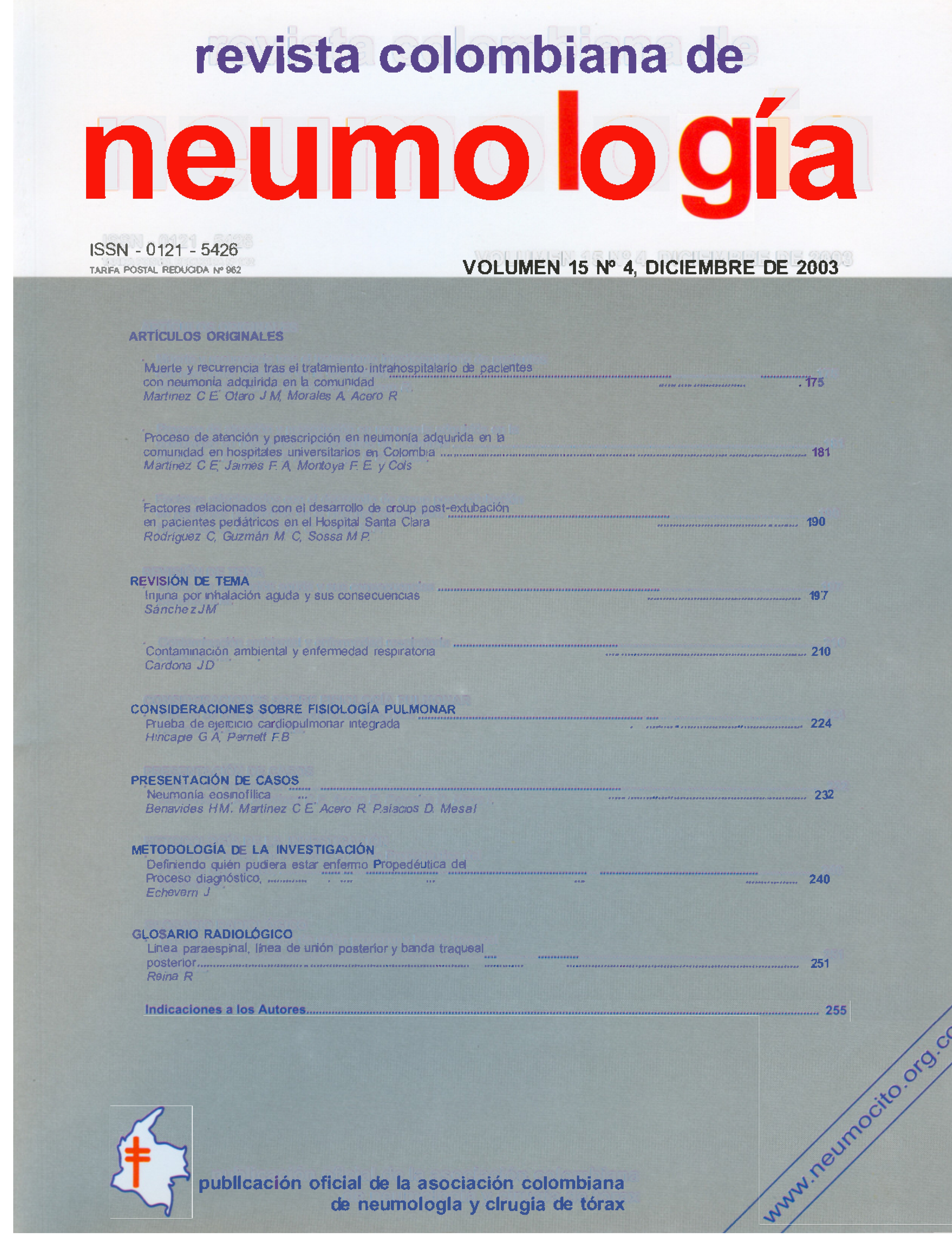Muerte y recurrencia tras el tratamiento intrahospitalario de pacientes con neumonía adquirida en la comunidad. Frecuencia y factores relacionados después de un año del egreso
Muerte y recurrencia tras el tratamiento intrahospitalario de pacientes con neumonía adquirida en la comunidad. Frecuencia y factores relacionados después de un año del egreso

This work is licensed under a Creative Commons Attribution-NonCommercial-ShareAlike 4.0 International License.
Ninguna publicación, nacional o extranjera, podrá reproducir ni traducir sus artículos ni sus resúmenes sin previa autorización escrita del editor; sin embargo los usuarios pueden descargar la información contenida en ella, pero deben darle atribución o reconocimiento de propiedad intelectual, deben usarlo tal como está, sin derivación alguna.
Show authors biography
Objective: To describe the frequency and related factors wíth death and relapse one year after a hospítal-treated epísode of communíty-acquíred pneumonía.
Design: Cohort study.
Setting: Fundación Santa Fe de Bogota, Bogota, Colombia.
Patients and Methods: Collectíon of clínical and demographíc data in adults wíth a CAP diagnosis at the time of admíssíon, íncludíng Fine 's pneumonía severíty índex (PSI). At least two íntents to contact the patíents were tríed after one year of the hospítalízatíon, askíng about CAP recurrence or death and death causes. Pertínent data were valídated by revíew of clínical records. Analysís as based on comparíson of frequency of the outcomes ( death and relapse) between groups wíth dífferent clínical characterístícs, past medical hístory and demographíc data.
Results: Duríng an 12-months períod 111 CAP patíents were díscharged alíve (55% males, mean age 66 years old). Response rate was 69% and follow-up was between 14 and 24 months. After díscharge mortalíty rate was 18% and relapse of CAP 20%. Factors related wíth death and relapse were the severíty of índex CAP (hígh group of PSI), age and hístory of heart faílure.
Conclusions: Sorne factors present at the time of díscharge after treatment of CAP are related wíth death and relapse and can ídentífy specíal groups candídate to elose follow-up and preventíve ínterventíons.
Article visits 38 | PDF visits 25
Downloads
- Halm EA, Teirsten AS. Management of community-acquired pneumonia. N Engl J Med 2002; 347: 2039-2045.
- Hedlund J.U., Ortqvist A.B., Kalin, M.E. Granath F., Factors of lmportance for the long term prognosis after hospital treated pneumonia. Thorax 1993; 48: 785-789.
- Hedlund JU, Ortqvist AB, Kali M, Scalia-Tomba G, Giesecke J. Risk of pneumonia in patients previously treated in hospital for pneumonia. Lancet 1992; 340: 396-397.
- Koivula l., Sten M., Makela P.H. Prognosis after Community Acquired pnumonia in the Elderly. Arch lntern Med. 1999; 159: 1550-1555.
- Zweig S., Lawhorne L Post R. Factors predicting mortality in rural elderly hospitalizad for pneumonia. J Fam Pract 1990; 30: 153-159.
- Fedson OS, Waida A, Nicol JP, Ros LL. ''The old man's friend" Lancet 1993; 342: 561.
- Brancati FL Chow JW, Wagener MM, Vacarello SJ, Yu VI. Is Pneumonia really the old rnans friend? Lancet 1993; 342:30-33.
- Mortensen E., Coley C.M., Singer O.E., Marrie T.J., Obrosky O.S., Kapoor W.N., Fine M .J. Causes of death for patients with community-acquired pneumonia. Arch lnter Med 2002; 162: 1059-1064.
- Zimmerman RK, Santibáñez TA, Janosky MJ y cols. What affects influenza vaccination rates among older patient, an analysis from inner-city, suburban, rural and Veterans Affaire practicas. Am J Med 2003; 114: 31-38.
- Zimmerman RK, Santibáñez TA, Fine MJ y cols. Barriers and facilitators of pneumococcal vaccination among elder1y. Vaccine 2003; 21: 1510-1517.
- Brull R, Ghali WA, Quan H. Missed opportunities for prevention in general interna! medicine. CMAJ 1999;160:1137-1140.







